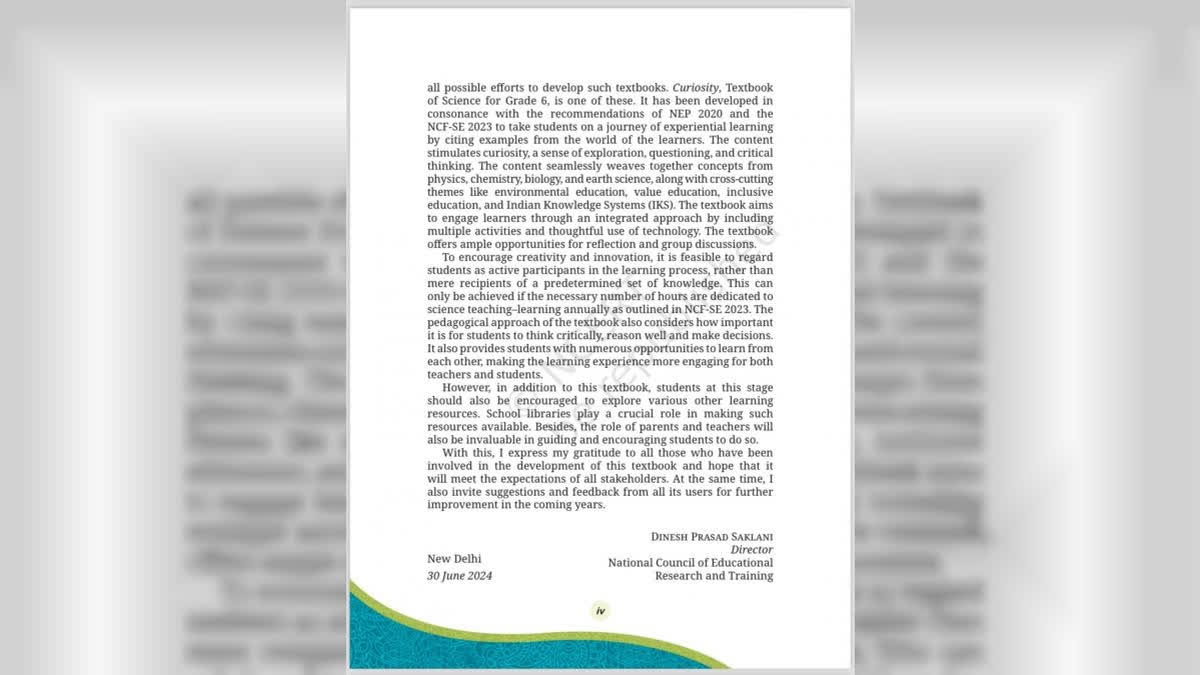New Delhi: The National Council of Educational Research and Training (NCERT) has released a new edition of its Class 6 science textbook, "Curiosity," which incorporates substantial changes to reflect Indian cultural and knowledge systems. This revised edition is designed to align with the National Education Policy (NEP) 2020 and aims to enhance students' engagement with Indian heritage and traditions.
Key Changes in the Revised Edition
1. Emphasis on Indian Culture: The updated textbook introduces characters from various Indian states to represent regional diversity. For example, Chapter 2, 'Diversity in the Living World', begins with illustrations of young students from Haryana. Chapter 11, 'Nature’s Treasures', features Kannada characters such as Bhoomi, Surya, and Ajji (grandmother). In Chapter 12, 'Beyond Earth', Ladakh is represented by characters Yangdol and Dorjay. These changes are intended to make the content more relatable to students across India.
2. Integration of Indian Texts: Several chapters now start with verses from ancient Indian texts. Chapter 2 begins with a Sanskrit verse that emphasises selflessness, translating to: "Trees stand in the Sun and give shade to others. Their fruits are also for others. Likewise, good people bear all hardships and bring welfare to others." This inclusion is part of a broader effort to instil a sense of rootedness and cultural awareness in students.
3. Revisions to Dietary Content: The chapter formerly known as 'Components of Food' has been renamed 'Mindful Eating: A Path to a Healthy Body.' This chapter now excludes references to non-vegetarian sources such as meat, eggs, and fish, and instead highlights vegetarian sources of fats like ladoo. Additionally, images of liver and lobster as protein sources have been removed, although fish and eggs are still depicted. Egg white has also been removed from the list of substances used in chemistry labs for tests related to starch, protein, and iodine.
4. Replacement of Western References: Western imagery and references have been replaced with Indian ones. For instance, the chapter 'Method of Separation of Everyday Substances' now features a 'Bharat ki yatra' (Journey through India) where characters explore Indian methods of substance separation, rather than including Western art like 'The Winnowers' by Gustav Courbet.
5. Introduction of Indian Astronomy: A new chapter titled 'Beyond Earth' explores Indian astronomy and traditional star nomenclature. This chapter explains that 'nakshatra' refers to both specific stars and constellations. It highlights ancient Indian names for visible planets, such as Ardr for the Betelgeuse star in the Orion constellation and Krittika for the Pleiades cluster in Taurus. Aldebaran, a prominent star in Taurus, is referred to as Rohini in Sanskrit.
6. Recognition of Indian Scientists: The revised textbook acknowledges notable Indian scientists, including Janaki Ammal, who is celebrated for her contributions to botany and environmental conservation. Ammal is described as a pioneering botanist dedicated to documenting and preserving India's rich plant biodiversity.
Official Comments
NCERT Director Dinesh Prasad Saklani emphasised that the revised textbook is designed to stimulate curiosity and critical thinking. In his preface, Saklani noted, "The content stimulates curiosity, a sense of exploration, questioning, and critical thinking. The content seamlessly weaves together concepts from physics, chemistry, biology, and earth science, along with cross-cutting themes like environmental education, value education, inclusive education, and Indian Knowledge Systems (IKS)."
Saklani also highlighted the integration of verses from Indian texts as a non-evaluative element intended to foster cultural rootedness among students, in line with the NEP 2020 objectives.
He added, "A non-evaluative interesting element that has been incorporated in some of the chapters is the introduction of certain verses from various Indian texts to promote rootedness in the learners as envisaged in NEP 2020."
'Curiosity' Textbook Highlights Indian Heritage and NEP 2020 Goals
The new edition of “Curiosity” represents a significant shift towards emphasising Indian cultural and educational heritage in the science curriculum for Class 6 students. By incorporating regional characters, traditional texts, and Indian scientific contributions, the textbook aligns with the NEP 2020's goals of fostering a deeper connection with Indian knowledge systems and promoting cultural awareness among young learners.



